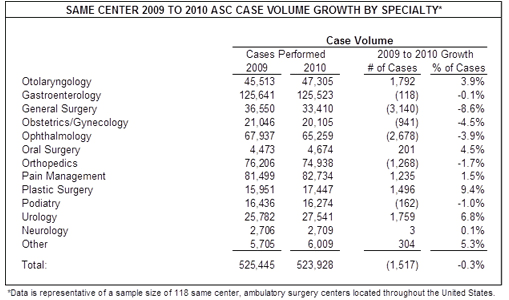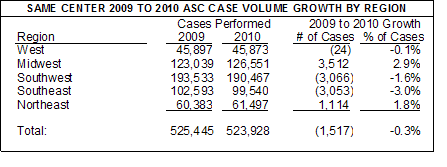The following article is written by Kevin McDonough, CFA, Senior Manager, and Colin Park, Senior Analyst, of VMG Health.
Part I: Same center volume trends
There was a collective hope by ambulatory surgery center market participants that performance declines experienced during 2008 and 2009 were only temporary and largely driven by extraordinary market dynamics brought on by the economic downturn that plagued the United States and world economies during this period. Growth would return to the ASC market as the economic environment as a whole gradually improved. It has been our observation, however, that performance trends in 2010 and early 2011 have not entirely supported such a theory. Although it's clear that the downturn accelerated and amplified declining performance trends, there continues to be numerous headwinds the industry is presently facing that are outside of the recent recession and subsequent sluggish recovery. These headwinds include the following:
- Oversaturation of ASCs in many markets.
- Increasing employment of specialists by health systems.
- Declining ability to bill and collect using an out-of-network strategy.
- Increasing consolidation within the managed care payor industry — large, poor reimbursing payors have an increased market share.
- Inability to recruit young physicians to replace high volume utilizers that are nearing retirement.
In an effort to further explore recent ASC performance, VMG conducted a study of same center volume and reimbursement trends and will highlight our observations in a two-part piece that focuses specifically on volume and reimbursement trends. This column, part I, will focus exclusively on same center volume trends, broken out by specialty and region. In part II, to be published in the near future, net revenue per case trends will be analyzed.
Within this study, 118 ASCs located throughout the United States were analyzed to compare 2009 to 2010 case volume and net revenue per case growth. Data was gathered using VMG Health's published Multi-Specialty ASC Intellimarker. Intellimarker is a compilation of information that provides detailed financial benchmarking information and analysis on ASCs around the United States.
Same center growth trends: aggregate and by specialty
As illustrated in the chart below, overall case volume for the 118 ASCs analyzed decreased from an aggregate 525,445 cases in 2009 to 523,928 cases in 2010. This represents a minimal decrease of 1,517 cases, or a 0.3 percent decrease.

Plastic surgery and urology cases, representing 3.3 percent and 5.3 percent of the 2010 total volume, respectively, show the largest percent growth in volume at 9.4 percent for plastic surgery and 6.8 percent for urology. As many of the plastic cases are definitively elective, the growth in volume suggests that those individuals electing to have such procedures performed have been relatively un-phased by the economic downturn. Urology also had the second largest increase in total cases with an additional 1,759 cases performed in 2010. Otolaryngology had the largest increase in total number of cases performed at 1,792 cases. An interesting trend to note related to plastics, urology and ENT is that physicians in these specialties have generally not been targeted by health systems for employment. This is a potential explanation for why we're observing growth in these specialties over others.
Representing 6.4 percent of the total 2010 volume, general surgery experienced the largest percentage and total case decline, declining from 36,550 cases performed in 2009 to 33,410 cases in 2010. Ophthalmology also had a large decline from 2009 to 2010, decreasing by 2,678 cases.
Gastroenterology, representing the largest percentage of the total case volume at 24.0 percent, experienced a very moderate case volume decrease of 0.1 percent, or 118 total cases. Pain management, with the next largest number of cases performed in 2010 at 15.8 percent of total volume, experienced a moderate increase in volume with 1,235 more cases performed in 2010 than 2009.
Same center growth trends: by region
The surgery centers used for this analysis were further analyzed by categorizing each center into the appropriate region of the United States as shown below:

Accounting for 24.2 percent of the 2010 case volume, the Midwest region experienced the largest increase in case volume, growing by 2.9 percent, as shown below. The most notable aspect of the Midwest region was the explosion in pain management (by specialty not shown) growth where there was a 16.8 percent increase from 2009 to 2010.

Representing 19 percent of the 2010 case volume, the Southeast region showed the largest decline in volume with a 3.0 percent decrease. The Southeast region experienced a decrease in case volume for every specialty with the exception of plastic surgery and general surgery. The largest decreases in case volume for the Southeast region was a 5.9 percent decrease in gastroenterology cases and a 6.7 percent decrease in ophthalmology cases. The most significant shift in case volume for the Southeast region was a 35.6 percent increase in plastic surgery cases.
The West region experienced the smallest percent change in case volume with a 0.1 percent decrease. The Southwest region had a 1.6 percent overall decrease in volume. The most notable decreases for the Southwest region included general surgery volume decreasing 12.5 percent and pain management decreasing 11.8 percent. The largest increase for the year was a 35.5 percent increase in urology volume.
The Northeast region experienced a 1.8 percent growth in overall case volume. Gastroenterology increased 17.9 percent with approximately 2,200 additional cases performed.
As illustrated in this analysis, we are observing flat to slightly declining volume trends throughout most of the country. Although the ASCs in this study do not represent all ASCs across the nation, the sample size certainly represents a population large enough to draw meaningful conclusions. It should be further noted that the ASCs in this study have come to our firm to provide transaction and valuation services. As such, these centers have active management that have consistently pursued physician recruitment and share movement within their ASC. This is a vital endeavor in positioning their respective ASC to be in the best possible position given the myriad of headwinds facing the industry.
Note: Look for part II of this study shortly. It will analyze reimbursement trends for the same centers by specialty and region.
Learn more about VMG Health.
More Articles Featuring VMG Health:
Though Similar to ASCs, Imaging Centers Experiencing Harder Times
50 Benchmarks on Surgery Center Case Volume
Compensating Physicians in Surgery Center Administrative Roles: Q&A With Ben Ulrich of VMG Health

